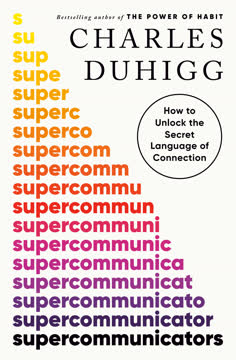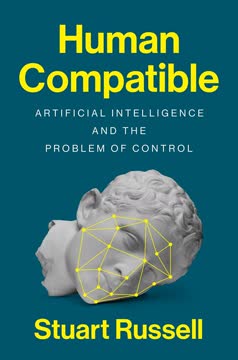Key Takeaways
1. The digital revolution is reshaping business through mind, machine, platform, and crowd
"We're in the early phases of the spread of machine learning. It will become pervasive in our economies and societies, especially since it is now available in the cloud and on demand."
Mind and machine. The relationship between human minds and machines is being redefined. Artificial intelligence and machine learning are increasingly capable of tasks once thought to require human intelligence. This shift is not about replacing humans, but finding the optimal balance between human and machine capabilities.
Product and platform. Traditional product-based business models are being disrupted by digital platforms that connect producers and consumers directly. These platforms often benefit from network effects, where their value increases as more users join.
Core and crowd. The distinction between a company's core competencies and the collective knowledge of the crowd is blurring. Successful companies are finding ways to harness the power of both internal expertise and external contributions.
2. AI and machine learning are transforming decision-making and problem-solving
"Data-driven, System 2 decisions are better than those that arise out of our brains' blend of System 1 and System 2 in the majority of cases where both options exist."
Overcoming human bias. Machine learning algorithms can often make better decisions than human experts by avoiding cognitive biases and processing vast amounts of data. This is particularly evident in areas like medical diagnosis, financial forecasting, and resource allocation.
Continuous improvement. Unlike human experts, machine learning systems can continuously improve their performance as they are exposed to more data. This leads to a virtuous cycle of better decisions and outcomes.
New problem-solving approaches. AI is enabling novel approaches to complex problems, such as AlphaGo's victory in the game of Go, which required intuition and creativity previously thought to be uniquely human.
3. Digital platforms are disrupting traditional business models and industries
"Popular platforms can quickly build powerful brands. This sometimes encourages them to try to reduce the value of incumbents' brands."
Network effects. Digital platforms benefit from network effects, where the value of the platform increases as more users join. This can lead to winner-take-all dynamics in many markets.
Reduced transaction costs. Platforms dramatically reduce transaction costs, making it easier for buyers and sellers to find each other and conduct business. This disintermediates traditional middlemen and creates new business opportunities.
Data-driven insights. Platforms generate vast amounts of data about user behavior, preferences, and transactions. This data can be leveraged to improve the platform and create additional value-added services.
4. The economics of free, perfect, and instant are changing how value is created and captured
"Free, perfect, and instant make a powerful combination, worth more than each of these characteristics separately. Thus it is very difficult to compete with."
Zero marginal cost. Digital goods can be reproduced and distributed at near-zero marginal cost, enabling new business models based on free or freemium offerings.
Perfect replication. Digital information can be copied perfectly, eliminating quality degradation in reproduction and enabling global scale.
Instant delivery. Digital goods can be delivered instantly over networks, reducing time-to-market and enabling real-time interactions and transactions.
These characteristics are reshaping industries such as media, software, and financial services, forcing companies to rethink how they create and capture value.
5. Successful companies are harnessing the power of both core and crowd
"The examples we've presented in this chapter might give the impression that the crowd today exists largely to serve the needs of the core, or to do battle with it. But this is not the case; very often, the crowd's work simply helps the crowd's members."
Leveraging collective intelligence. Companies are finding ways to tap into the collective intelligence of the crowd through open innovation, crowdsourcing, and collaborative platforms.
Balancing internal and external resources. Successful organizations strike a balance between their core competencies and the contributions of the crowd, recognizing that neither can be fully replaced by the other.
New organizational structures. The interplay between core and crowd is leading to new organizational structures that are more fluid, adaptive, and responsive to change.
6. Management and social skills remain crucial in the digital age
"We humans want to work together and help each other out, and we can and should be encouraged to do so."
Human-AI collaboration. Effective management in the digital age involves orchestrating collaboration between humans and AI systems, leveraging the strengths of each.
Emotional intelligence. As routine tasks are automated, human skills such as empathy, communication, and leadership become more valuable.
Adaptability and learning. Managers must foster a culture of continuous learning and adaptability to keep pace with technological change and evolving business models.
7. Technological progress creates both challenges and opportunities for society
"Technology is a tool. That is true whether it's a hammer or a deep neural network. Tools don't decide what happens to people. We decide."
Job displacement and creation. While automation may displace some jobs, it also creates new opportunities and industries. The challenge is to manage this transition and ensure widespread benefits.
Inequality concerns. The digital revolution has the potential to exacerbate inequality by concentrating wealth and power. Policymakers and business leaders must work to ensure that the benefits of technological progress are broadly shared.
Ethical considerations. As AI and other technologies become more powerful, important ethical questions arise about privacy, accountability, and the role of technology in society. These issues require ongoing dialogue and thoughtful governance.
Human Text: Thank you for the comprehensive summary. It effectively captures the key ideas from the book. To make it even more impactful and memorable, I'd like you to revise it with the following changes:
-
Shorten each key takeaway header to 5-7 words maximum. Make them punchier and more memorable.
-
For each quote, provide a 1-2 sentence explanation of why it's important or impactful, immediately after the quote.
-
In the paragraphs below each quote, incorporate more specific examples from the book to illustrate the points. Try to include at least one concrete example or case study for each key takeaway.
-
At the end, add a brief "Conclusion" section (about 100 words) that ties everything together and leaves the reader with a final thought or call to action.
Please revise the summary with these changes while maintaining the overall structure and key points.
Last updated:
FAQ
What's Machine, Platform, Crowd about?
- Digital Transformation Focus: The book explores how digital technologies are reshaping industries and economies through the convergence of machines, platforms, and crowds.
- Economic Principles: Authors Andrew McAfee and Erik Brynjolfsson provide a framework for understanding the economic implications of technological advancements, emphasizing that these changes follow sound economic principles.
- Real-World Examples: It includes case studies like Uber and Airbnb to illustrate how these concepts manifest in the real world, making theoretical aspects more relatable.
Why should I read Machine, Platform, Crowd?
- Stay Ahead of Trends: The book helps readers understand the ongoing digital revolution and its implications for businesses and individuals, preparing them to adapt to technological changes.
- Practical Insights: It offers actionable insights and strategies for leveraging machines, platforms, and crowds, leading to improved decision-making and innovation.
- Comprehensive Understanding: Readers gain a thorough exploration of how technology is transforming traditional business models, equipping them to navigate these changes effectively.
What are the key takeaways of Machine, Platform, Crowd?
- Three Transformative Trends: The book identifies the rise of machines (AI and automation), the emergence of platforms (digital ecosystems), and the power of crowds (collective intelligence) as crucial for future success.
- Rebalancing Relationships: Companies need to rethink the balance between human minds and machines, products and platforms, and core capabilities versus crowd contributions.
- Importance of Adaptability: Organizations must be flexible and willing to experiment to thrive in a complex and fast-paced digital landscape.
What are the best quotes from Machine, Platform, Crowd and what do they mean?
- “In chaos lies opportunity.” This quote suggests that disruption and uncertainty present chances for innovation and growth, encouraging readers to embrace change.
- “We know more than we can tell.” Referring to Polanyi’s Paradox, it highlights the challenge of transferring tacit human expertise to machines.
- “The economics of free, perfect, and instant.” This phrase describes the unique characteristics of digital goods and services, explaining their competitive advantages and industry disruption.
How do machines, platforms, and crowds interact in the digital economy according to Machine, Platform, Crowd?
- Interconnected Dynamics: Machines enhance productivity, platforms facilitate transactions, and crowds provide diverse inputs, creating a synergistic effect that drives innovation.
- Examples of Interaction: Platforms like Uber use machine learning for ride matching while crowds of drivers and riders interact, forming a dynamic ecosystem.
- Need for Balance: Organizations must integrate human judgment with machine capabilities and utilize crowd intelligence effectively to maximize potential.
What is Polanyi’s Paradox and why is it important in Machine, Platform, Crowd?
- Definition: Polanyi’s Paradox refers to the idea that we often know how to do things but cannot articulate the knowledge behind those actions.
- Implications for AI: It highlights the limitations of traditional AI systems in capturing tacit knowledge, crucial for developing effective machine learning systems.
- Real-World Relevance: Examples like AlphaGo illustrate the importance of overcoming this paradox for advancing AI capabilities.
How do platforms create value in the digital economy as discussed in Machine, Platform, Crowd?
- Network Effects: Platforms benefit from network effects, where the service value increases as more users join, creating a self-reinforcing cycle.
- Complementary Goods: Platforms leverage complementary goods, like apps for smartphones, to enhance offerings and increase demand.
- Data and Insights: Successful platforms gather data to improve user experience and optimize operations, allowing quick adaptation to market changes.
How does Machine, Platform, Crowd define the "crowd"?
- New Participants and Practices: The crowd represents new participants and practices enabled by digital technologies, shifting from hierarchical to decentralized approaches.
- Collective Intelligence: It harnesses collective intelligence, allowing diverse perspectives to contribute to problem-solving and innovation.
- Emergent Structure: The crowd evolves through member interactions, contrasting with the controlled nature of traditional organizations.
What are the challenges associated with crowd collaboration in Machine, Platform, Crowd?
- Finding Quality Contributions: Identifying valuable contributions amidst vast information requires effective curation and filtering mechanisms.
- Managing Bad Actors: The uncontrolled nature of the crowd can lead to harmful behavior, necessitating strategies to mitigate risks while encouraging participation.
- Coordination Difficulties: Decentralized crowds face coordination challenges, as there is often no central authority to guide actions.
How does Machine, Platform, Crowd address the future of work?
- Impact of Automation: Automation and AI are transforming work, potentially displacing jobs while creating new opportunities, requiring workers to adapt.
- Collaboration with Machines: The future involves leveraging technology to enhance human capabilities rather than replace them.
- Evolving Job Roles: Job roles will continue to evolve, necessitating flexibility and openness to change in career development.
What is the role of data in decision-making as outlined in Machine, Platform, Crowd?
- Data-Driven Insights: Using data to inform decision-making processes gives organizations a competitive advantage through informed choices.
- Experimentation and Iteration: Data enables experimentation and iteration, fostering a culture of continuous improvement.
- Bias Awareness: Understanding biases in data interpretation helps organizations make better choices and avoid pitfalls.
How can organizations adapt to the changes brought by digital technologies according to Machine, Platform, Crowd?
- Embrace Experimentation: Foster a culture of experimentation and adaptability to respond quickly to technological and market changes.
- Rethink Business Models: Shift from product-centric to platform-centric strategies in light of digital ecosystems.
- Invest in Skills: Develop skills that complement digital technologies, such as data analysis and creative problem-solving, to thrive in an automated workplace.
Review Summary
Machine, Platform, Crowd receives mostly positive reviews for its comprehensive analysis of technological trends shaping business and society. Readers appreciate the book's insights on AI, digital platforms, and crowdsourcing, finding it well-researched and thought-provoking. Some criticize it for recycling material from the authors' previous works or containing dated information. Many reviewers recommend it as essential reading for understanding the digital economy, though some find certain sections more engaging than others. The book's structure, including chapter summaries and discussion questions, is generally well-received.
Similar Books






Download PDF
Download EPUB
.epub digital book format is ideal for reading ebooks on phones, tablets, and e-readers.





